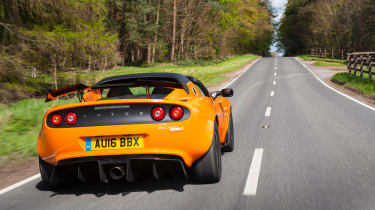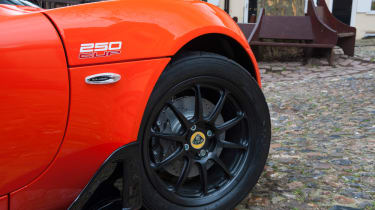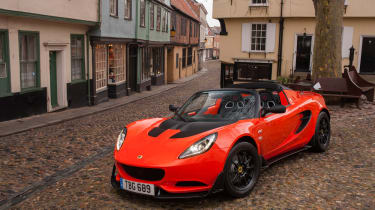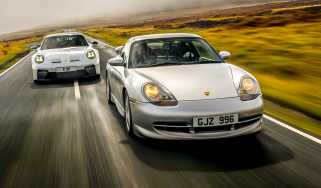2016 Lotus Elise Cup 250 review - the fastest Elise ever
Even lighter, even faster and even more exciting?
The new Elise Cup 250 is the fastest Elise ever and only 200 will be built per year. More of the same or something to genuinely be excited about?
What is it?
A two-seater sportscar with a stiff, lightweight aluminium tub and powered by a high-revving supercharged 1.8-litre four-cylinder engine producing 243bhp. It weighs just 931kg and focuses purely on feedback, balance and excitement. There’s not even any power steering.
Ok, you’re not stupid. You know all this stuff. It’s an Elise, engineered to same formula we’ve grown used to for over two decades now. But it’s worth writing down those salient points in isolation and remembering just what a unique and special little car it is. Imagine if Porsche brought out a lightweight sportscar now, resurrected the ‘550 Spyder’ name and it ended up at well under a tonne with mini-supercar looks, compact dimensions and an ability to lap a circuit all day long or stream through the countryside offering incredible balance, transparency and pure, simple fun. What would you pay for that? Well, for the Cup 250 you’ll need to find £45,600 – just over £5000 less than a new 718 Boxster S.
Technical highlights?
Of course that is still a big chunk of money for a car that doesn’t come with air-conditioning and a stereo as standard. So what does this Elise offer and how is it different from the previous 220 Cup (aside from the obvious)? Yep, power is up to 243bhp at 7200rpm and while torque remains unchanged at 184lb ft, it’s available over a much wider range - from 3500-5500rpm instead of peaking at 4600rpm. Lotus claim 0-60mph in 3.9-seconds and a top speed of 154mph.
More reviews
Group tests
In-depth reviews
Reviews
- Analogue Lotus Elise SuperSport review: the Elise perfected?
- Lotus Elise Cup 250 review
- Lotus Elise review – is the featherweight sports car as good as ever?
- Lotus Elise Sprint 220 review – is this the sweet spot in the Elise range?
- Lotus Elise S Cup review - prices, specs and 0-60 time
- Lotus Elise S Club Racer review, specs and performance
Perhaps of even more significance is the detail change in the chassis, structure and interior. A trip to Lotus’ ‘Lightweight Lab’ shed 21kg thanks to a new lithium-ion battery (-10kg), carbon fibre seats (-6kg) and lighter forged wheels (-1.5kg), amongst other things. You’ll notice there’s a new look thanks to much revised aerodynamics, too. Lotus claim the new front splitter, side sills, rear diffuser and wing produce combine to produce 66kg of downforce at 100mph and 155kg at vmax. You can have the aerokit in carbon fibre to save another 10kg.
>Read our Alfa Romeo 4C review
On the chassis side, the spring rates, Bilstein dampers and anti-roll bars remain unchanged but the front Yokohama AO48 tyre has gone up from 175 to 195-section. Lotus has also remapped the throttle response for a more intuitive, snappier feel. Despite the lightweight ethos it retains ABS, traction and stability control. Sport mode acts to speed throttle response still further and gives access to a more permissive traction control setting.
What’s it like to drive?
It’s been a while since I’ve driven an Elise but all stills feels familiar. The cabin is very snug but quality has definitely taken a little jump up – there are even leather covered air vents for the Cup 250! The feeling once you folded yourself down to the driver’s seat (made easier as it’s a lovely day and the roof is removed) is incredibly evocative. The steering wheel is small with a perfectly judged thickness, behind it are two simple dials and the view is framed by the crisp lines of the front wings. For me the seats remain a weak point – they look great but I’ve never found them to be very supportive nor comfortable.
Twist the key, press the start button and the Toyota engine starts with barely a whisper and at idle it just gently ticks away. There is zero drama and none of the naughty blare you might expect of a little sportscar with a high-tuned four-cylinder engine. The gearbox feels much, much better than before, though. The rattly, loosely defined shift is now positive and feels more robust.
As you slide from 1st to 2nd you’ll already be utterly blown-away by the Cup 250’s steering. It is fabulously detailed. In fact, now that EPAS features even in the very best sportscars, the non-assisted rack of the Elise feels better than ever. If you’ve read about ‘steering feel’ and not really understood what it means, I’d urge you to seek out an Elise and be forever enlightened. The result is that the Cup 250 puts you in tune with everything that it’s doing from the moment the wheels are rolling. The ride is also superbly judged. You might expect a car with such obvious track credentials to be harsh on lumpy lanes but in fact it’s supple and light-footed. The feeling of low mass pervades everything. The AP Racing brakes are also phenomenal. The first couple of millimetres of pedal travel is dead but once you’re into the operating range the pedal has a firmness and consistency that’s better than any Elise I’ve tried previously and the ABS never triggers on the road.
If only the engine sounded better. Throttle response is indeed improved and I love the way the delivery ramps up from 6500rpm to 7200rpm but the soundtrack really is thin and forgettable. I’m not suggesting the Elise needs a load of silly digitally-programmed pops and bangs but a bit of rortiness to go with the really hard-edged performance would transform the experience, I think. It’s a tough little car with masses of grip and agility and deserves a noise to match it’s personality.
The Cup 250 really carries good speed across the ground and its amazing poise means the balance is rarely upset. In fact there’s so much mechanical grip that under- and oversteer aren’t really on the menu. You just flow along, every last horsepower easily accessible and the car zinging with feedback. If you want to feel a car moving around and adjusting its line with your every input, then this Elise probably isn’t for you. However, on the rare occasions that you find the perfect, clear-sighted corner you can kill the mild on-limit understeer with a bootful of power as the Sport traction setting allows the tyres to spin-up just enough to induce a little smudge of oversteer.
On track you can obviously find the limits more readily. The mission statement of the car is to create a very grippy, neutral trackday car for people who want to go fast with a good degree of security. And one that’ll lap all day without wilting. It certainly shows no sign of fatigue around Hethel despite the test car having already been through the hands of three or four people by the time I get my laps. The balance tends towards understeer and there’s no limited-slip differential, which can be frustrating. However, learn to trail the brakes ever so slightly and the car rediscovers a nice neutral balance and the quicker you go the more you feel able to tweak the car’s behaviour mid-corner. Even so the Cup 250 remains a car that impresses more with grip and composure than outright adjustability.
Lotus would point out that if you want even more track ability you can progress to an Exige Sport 350… But I have to say if I’d spent £45,600 on an Elise I’d want to feel it was already an ultimate of sorts. I’d love for the balance to be a bit pointer and to see a limited-slip differential as standard – even if it cost a few kilos. On the road it’s right on the money but for the track – and surely most will find their way onto a circuit regularly – perhaps it places too much emphasis on grip and security and could afford to dial-in a bit more pure entertainment.
Rivals
Obviously the Elise Cup 250 requires considerably more sacrifice to drive every day than a Boxster S, but it is a more special car to drive. It really does feel light and nails that mini-supercar experience brilliantly, aside form the rather weedy noise. It really does fly, too. The Elise remains a car for those absolutely dedicated to the Lotus way, just as it should.
>Read our Porsche 718 Boxster S review
Anything else I need to know?
The carbon aero pack costs £4000 and sheds a further 10kg. Buy it to not feel as guilty when you tick the box for air conditioning (£1250).
| Engine | 1798cc, in-line 4-cyl, 24v, supercharger |
| Power | 243bhp @ 7200rpm |
| Torque | 184lb ft @ 3500-5500rpm |
| 0-60mph | 3.9-seconds (claimed) |
| Top speed | 154mph (claimed) |
| CO2 | 175g/km |
| Price | £45,600 |







